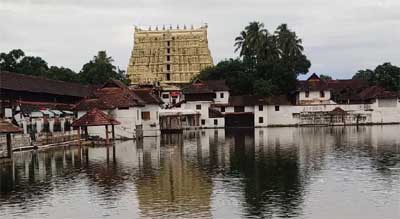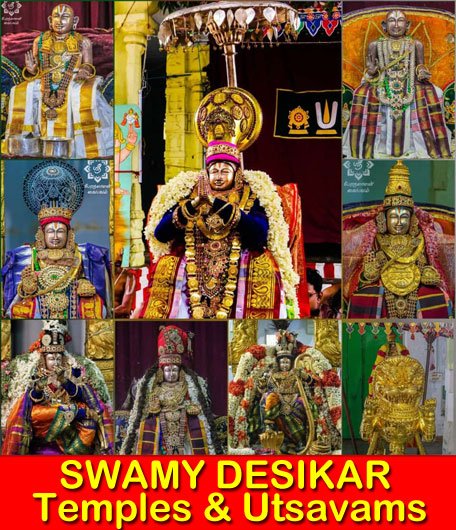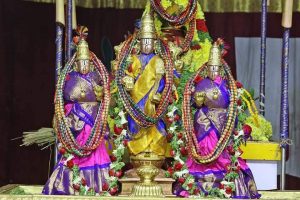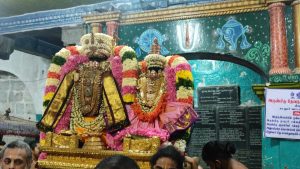The devotees are aware that Padmanabhaswamy temple, situated in Thiruvananthapuram at Kerala is dedicated to Lord Maha Vishnu. Notably, it is one of the 108 Divya Desams, which are considered the sacred abodes of Vishnu in the Sri Vaishnava tradition. It is pertinent to note that the name of Thiruvananthapuram in Malayalam and Tamil translates to ‘The City of Ananta’, as Ananta denotes a form of Vishnu. However, it may be recalled that Thiruvananthapuram was earlier named as ‘Thiruvendram’ and ‘Kozhikode’ was named as ‘Calicut’. The renowned temple was built that ideally suits the Kerala and the Dravidian style of architecture, featuring high walls, as it is a 16th-century Gopuram.
It is important to note that extant Hindu texts, including the Puranas, ranging from Vishnu, Brahma, Matsya, Varaha, Skanda, Padma, Vayu and Bhagavata, besides the Mahabharata informs us the details related to Padmanabhaswamy temple.Importantly this temple, has been referred to in the Sangam period literature time without number. A section of conventional historians and scholars are of the opinion that the name, ‘The Golden Temple’, was inscripted, keeping in cognisance of the temple being wealthy around that time. Many valuable pieces of Sangam Tamil literature and poetry, as well as nineth century of Tamil poet saints like ‘Nammalwar’ refer to the temple and the city, as having walls of pure gold. Interestingly, the fabulous temple is treated as heaven by many worshippers, who indulge in religious fervour.
It is believed that Parasurama purified and venerated the idol of Padmanabhaswamy in ‘Dvapasra Yuga’ about 5100 years ago. For instance, ‘Parasurama’ entrusted ‘Kshethra Karyam’ (administration of the temple) with seven Potti families, namely, Koopakkara Potti, Vanchiyoor Athiyara Potti, Kollur Athiyara Potti, Muttavila Potti, Karuva Potti, Neythasseri Potti and Sreekaryathu Potti. The story goes around that the then king ‘Adithya Vikrama’ of Vanchi was tasked with the responsibility by Parasurama to perform ‘Paripalanam’ (protection) of the temple. Parasurama gave the Tantram of the temple to Tharananallur Namboothiripad. This legend is narrated in the ‘Kerala Mahathmayam’, which forms part of the ‘Brahmanda Puranam’.
Another version regarding the consecration of principal idol of the temple relates to the legendary sage ‘Vilvamangalathu Swamiyar’, who offered worship to Vishnu for his ‘darshan’. The god was supposed to have entered in the guise of a little kid. When the sage wanted the boy to reside with him, the little lad put a condition that he should be treated like any other human being. The sage agreed to his aspirations and enjoyed his childlike activities. However, he lost his patience and temper, when, one day, the boy defiled the idol, which was kept for the purpose of puja.By the time he realised the gravity of the situation and chased the boy, he disappeared within no time. Realising that the god entered in his life in the guise of a little boy, the sage wept for forgiveness and urged him for another darshan.
However, the sage heard a voice uttering: “If you want to see me, come to the Anathavana (the unending forest or Ananthakadu). After a long search, when the sage was walking on the banks of the Laccadive Sea, he heard a ‘pulaya’ lady warning her child that she would throw him in ‘Ananthankadu’. The moment sage heard that word he went to the destination concerned, based on the directions of the lady. When he reached Ananthankadu, he saw the boy merging into an ‘Iluppa tree’ (Indian butter tree). The tree fell down and became ‘Anantha Sayana Moorti’ (Vishnu reclining on the celestial snake Anantha).
Long ago, several families of ‘Vrishni Kshatriyas; travelled to the south, carrying with them idols of Lord Balarama and Krishna. When they reached the land of Sree Padmanabha, they gave the idol of Balarama, also known as ‘Bhaktadasa’, to ‘Neythasseri Potti’, who built a temple at ‘Budhapuram’, as it is known as Kanyakumari District now, and had this idol installed there. Incidentally, the ‘Vrishnis’ gifted the idol of Krishna to ‘Maharaja Udaya Marthanda Varma’ of ‘Venad’. The Maharaja constructed a separate shrine, known as ‘Thiruvambadi’, in the premises of Padmanabhaswamy temple for this idol, as the renowned shrine enjoys an independent status, since Thiruvambadi has its own Namaskara Mmandapam, Bali stones and flagmast.
It may be noted that the deity of Thiruvambadi is Parthasarathi, the divine charioteer of ‘Arjuna’, the warrior prince in Mahabharatha. On ‘Ekadasi’ days, the deity is dressed and decorated as ‘Mohini’.The deities who settled at Venad are known as ‘Krishnan Vakakkar’, as they belong to the lineage of Krishna.There are many festivals associated with this temple. For example, the ‘Aipasi’ and ‘Panguni, falls in the Tamil month of October and November and March and April, respectively, that lasts for ten days. On the ninth day, the Maharajah of the Travancore, entering in the form of ‘Thrippappoor Mooppan’, escorts the deities to the destination.
The festivals culminate with ‘Aarat’ (holy bath) procession to the beach. Subsequently, the Maharajah escorts the ‘Aarat’ procession on foot. Later, the idols Utsava Vigrahas of Padmanabhaswamy, Narasimha Moorthi and Krishna Swami, among others, are given a ritual bath in the sea, after performing the prescribed pujas. Ultimately, the idols are then taken back to the temple in a procession, marking the conclusion of the festival.Navaratri is one of the major festivals performed at Padmanabhaswamy temple. The idols of ‘Saraswati Amman’, ‘Mun Uditha Nangai’ ( Parasakti), who appeared before the goddess trio, ‘Saraswati’, ‘Lakshmi’ and Parvathi’to assist them in identifying their better-halves, who had been transformed into infants by the power of chastity of Anasurya, besides Lord Murugan are brought from the Padmanabhapuram palace, Suchindram, and Kumarakovil, respectively to the ‘Kuthira Malika’ palace in front of Padmanabhaswamy temple as a procession.
The above festival lasts for nine days, similar to Navaratri. ‘Swathi Sangeethotsavam’, a popular music festival is held every year during this festival, as it was named in honour of the Maharajah of Travancore, ‘Swathi Thirunal Rama Varma’ and is organised by his descendant in the Royal Family, ‘Prince Rama Varma’. Therefore, it is not surprising that Padmanabaswamy temple has carved out a nich for itself and created a lasting impression among the devotees, who throng around the temple to have a glimpse of the almighties with utmost delight time and again.
K.V. Venugopal








